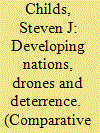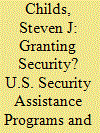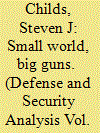| Srl | Item |
| 1 |
ID:
181990


|
|
|
|
|
| Summary/Abstract |
Ensuring the survivability of second-strike nuclear forces is critical for strategic stability, yet some scholars contend that technological changes in surveillance by established nuclear powers are reducing their survivability in a new era of counterforce. What are the implications of the proliferation of unmanned aerial vehicles (UAVs) on deterrence between small nuclear powers (SNPs)? Would these systems allow SNPs to appreciably increase their confidence in counterforce targeting? This article examines developments in the India–Pakistan dyad to consider how the proliferation of UAVs to SNPs might alter the decision calculus regarding preemptive strikes.
|
|
|
|
|
|
|
|
|
|
|
|
|
|
|
|
| 2 |
ID:
168850


|
|
|
|
|
| Summary/Abstract |
U.S. security assistance programs are expected to increase the capabilities of partners in the Middle East and Africa by leveraging the provision of armaments and training through foreign aid. Can policymakers increase their reliance on such programs to achieve foreign policy aims of promoting regional stability while retaining political flexibility? Using multivariate logistic regression of Middle East and African states spanning 1970 to 2015, the empirical findings suggest that U.S. programs geared toward education and training are more positively correlated with stability than programs oriented toward providing hardware.
|
|
|
|
|
|
|
|
|
|
|
|
|
|
|
|
| 3 |
ID:
120429


|
|
|
|
|
| Publication |
2013.
|
| Summary/Abstract |
This article examines the contemporary phenomenon of suicide attacks by fusing network analysis and time-series econometrics. We find that a global network of militant organizations drives the reproduction of the suicide-attack phenomenon, and brokers within the network mark the primary perpetrators and diffusers of the tactic. The introduction of a fourth level of analysis of political violence demonstrates that network connections between organizations form a system that perpetuates suicide attacks. An organization-level analysis reveals that ideological congruence facilitates the establishment of network connections. As exemplified by the wide range of employers and targets, and moreover by the generation of an autogamous function, contemporary suicide attacks represent a unique sociopolitical phenomenon. Accordingly, organizations that use the tactic warrant a distinct classification.
|
|
|
|
|
|
|
|
|
|
|
|
|
|
|
|
| 4 |
ID:
116070


|
|
|
|
|
| Publication |
2012.
|
| Summary/Abstract |
With the burgeoning influence of emerging markets in Asia, a tectonic shift is taking place in the global security landscape. Asian states are concomitantly arming as their economic clout grows. In light of these developments, security analysts would benefit from a formal means of placing these arms acquisitions in a structural context. Are arms acquisitions on par with the expectations of Asian states, given their structural dispositions, or are recent acquisitions beyond anticipated levels? By using a dynamic panel regression of 187 states from 1950 to 2011, this research predicts arms import volume using the degree of interstate arms linkages, the size of a state's military, and its level of economic development. The technique offers analysts a formal means of distinguishing orthodox behavior in importing conventional weapons from extraneous security motivations. The article concludes by generating near-term forecasts of Asian arms imports and discussing the implications of the technique.
|
|
|
|
|
|
|
|
|
|
|
|
|
|
|
|